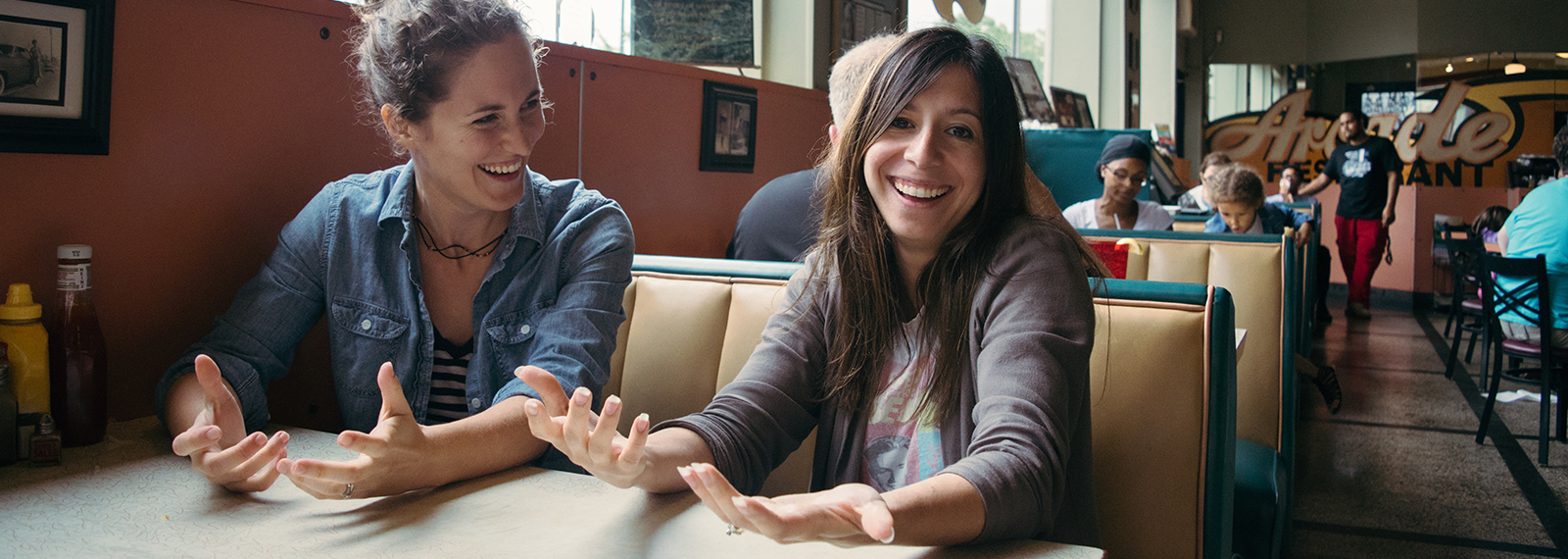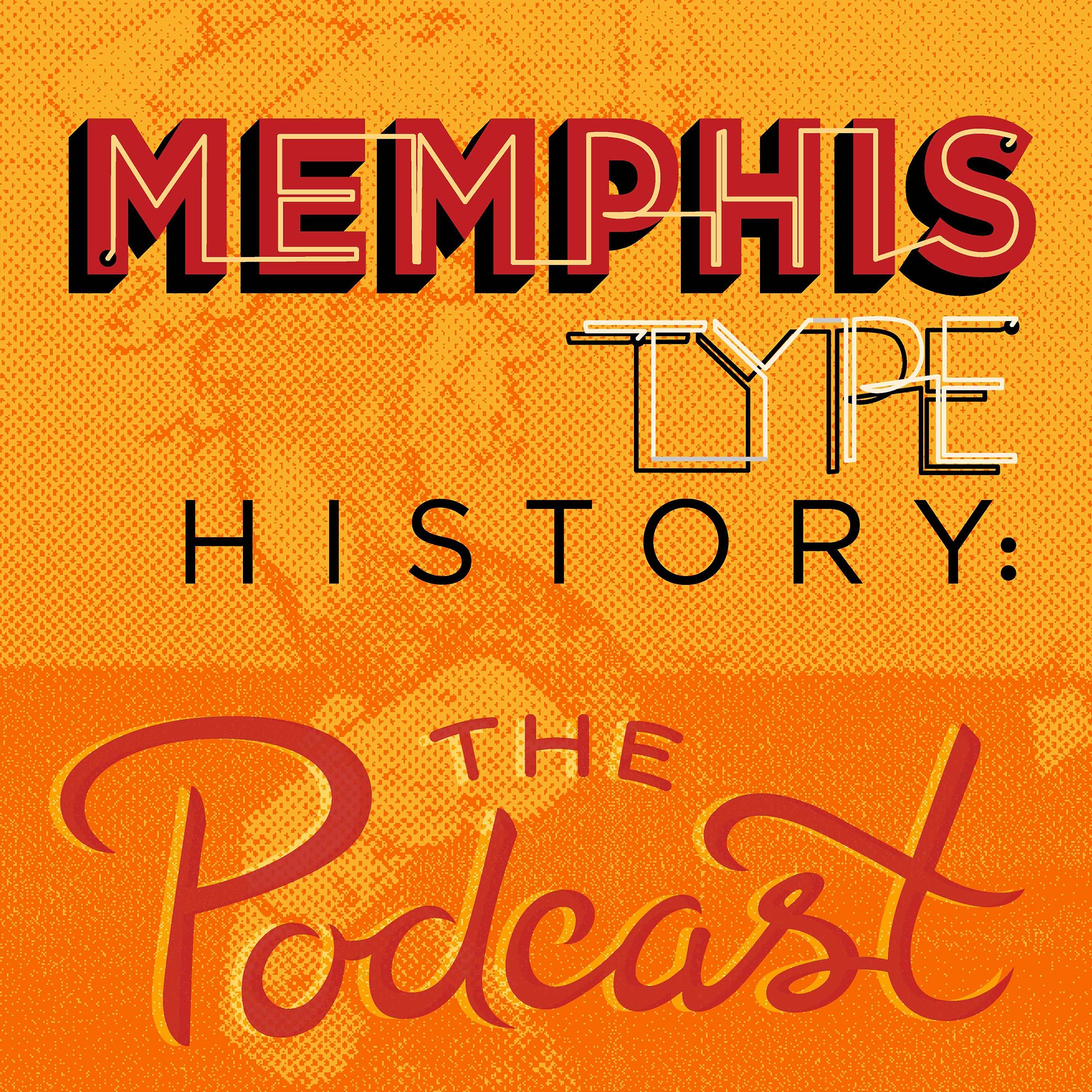Episodes
![Your Attention Please [Hiatus]](https://pbcdn1.podbean.com/imglogo/ep-logo/pbblog1800607/MTH_podEpisode49_300x300.jpg)
Sunday Oct 21, 2018
Your Attention Please [Hiatus]
Sunday Oct 21, 2018
Sunday Oct 21, 2018
In this episode of Memphis Type History: The Podcast, Caitlin and Rebecca tell you why they have been missing in case you've been wondering. But don't fret, they'll be back! In the meantime, tune in to hear what's brewing for Memphis Type History and look ahead for a new batch of episodes to come.
There is so much more history in this city to discover so of course they will continue. In the meantime, take a moment to catch up on listening or listen back to some of our personal favorites that we mention in this episode.
For full show notes, visit memphistypehistory.com/hiatus

Sunday Jun 24, 2018
Zines 101 with Erica Qualy
Sunday Jun 24, 2018
Sunday Jun 24, 2018
In this episode of Memphis Type History: The Podcast, Rebecca has a conversation with Erica S. Qualy to learn all about the art of zines. What are they? What is the purpose? Can anyone make their own? We answer those questions and more for your enlightenment and for the annual Memphis Zine Fest that is open for all to attend!
If you're familiar with our book, you may recognize Erica's name from our chapter of the Lorraine Motel. She's actually the one who sparked Rebecca's interest in zines in the first place.
So, what is a zine?
A zine is a do-it-yourself publication produced in editions of less than 100. Usually it's just an 8.5x11 piece of paper folded up and stapled with whatever content you want to tell. At first, everything was cut and paste and hand-drawn, but now people have the ability to include photoshop elements. Erica states that she herself is a purist and sticks to the cut and paste method. She also gives insight on what her process is which you can hear on this episode. For example, Erica uses her own typewriter.
Where did the zine start?
That's a good question. Some people would consider tracing zines back to Martin Luther's Ninety-five Theses written in 1517. But the fandom of science fiction works in the 1930s is what really set it off. Fans published and traded their own stories and those became known as "fanzines" the abbreviation of fan magazine and later shortened to just zine (zeen).
Erica touches on some great material she researched but makes a point to call out that the zines we most commonly reference came from 70s because that was the start of newer technologies that allowed these to be easier to produce. In the 70s and 80s is when the punk scene entered influencing the voice and art of zines. Even into the 90s a lot of band used zines to produce their own voice, awareness, feminism, and empowerment.
Most importantly, visit the Memphis Zine Fest!
Thanks to Erica and Crosstown Arts, artists are able to showcase and sell their own zines each year during the Memphis Zine Fest. This year's fest will be Friday, July 20 at the theater stairs in the central atrium of Crosstown Concourse. It's free to attend and open to all ages from 4P–7P but bring some cash so you can buy some fun zines and support the arts.
And if you're interested in becoming a zine maker (which you probably are now), you can apply to be a vendor at the event! Just visit crosstownarts.org.
For full show notes, visit memphistypehistory.com/zine
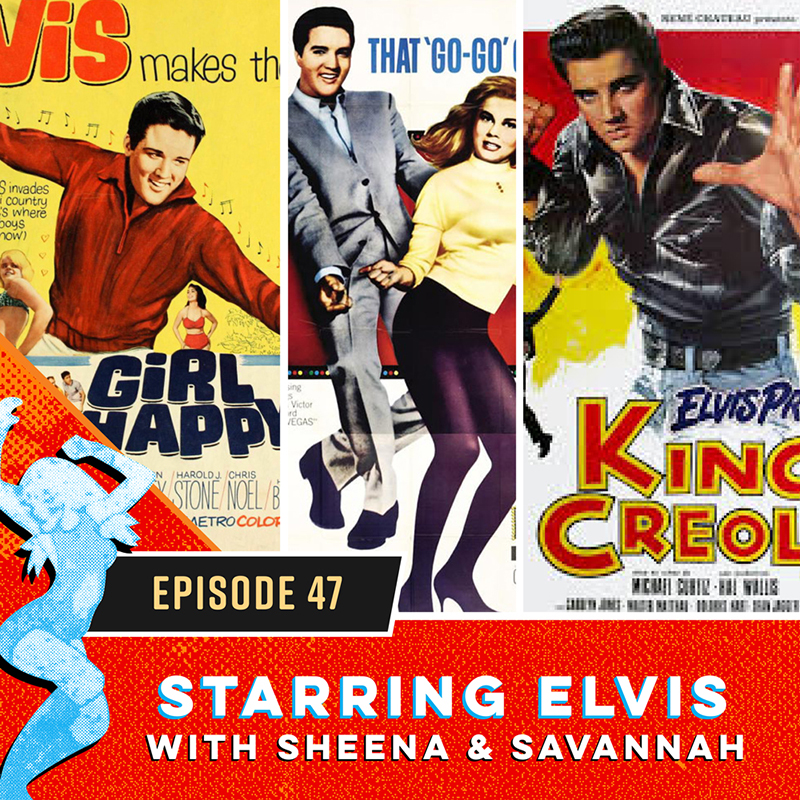
Monday May 28, 2018
Starring Elvis with Sheena and Savannah
Monday May 28, 2018
Monday May 28, 2018
In this episode of Memphis Type History: The Podcast, Rebecca meets Sheena and Savannah, two spectacular ladies of Graceland, who currently run a Podcast series entitled "Starring Elvis." Whether you're an Elvis fan or not, learning about the movies the artist put his heart into and the songs that came from them is surprising. You'll hear about Sheena and Savannah's Elvis favorites, some Elvis movie history, and what inspired the the two to start this charming series in the first place.
It all started with Dawson's Creek. Well, not the show, but the podcast with fans of the show talking about each and every episode. While Sheena and Savannah were inspired by that show's podcast, their Elvis movies podcast takes a whole other bent on the idea, focusing on the movies that really solidified the status of the king in the years after he returned from war.
The hosts even run down the list of all the world-renowned actors that were in those early films with Elvis. That's just one reason they say, be careful if you assume all the films are silly or campy. One of the films in particular featured has a really interesting connection to Casablanca.
Elvis the Actor
Elvis made 31 feature films and even did a couple of concert documentaries, as well. Of those, our guests had some favorites. Our guests are particularly impressed with King Creole because it gives Elvis a real opportunity to show acting skills that were often left out in his films in favor of assumed commercial success. He portrays a character with some real depth, co-stars with Anne Margaret, and the film was directed by Michael Curtiz.
Of course, Elvis really shines in the dancing and singing sequences in his films. The ones especially worth checking out—Jailhouse Rock and Love Me Tender. The ladies say those films demonstrate his star power was really connected to his performances within the films.
The Leading Ladies
Elvis' leading ladies are well-known and many went on to have pretty impressive careers themselves. Ann Margaret, Nancy Sinatra, and Shelley Fabares are just some of the names that came up in our conversation. Of particular note was Ann Margaret performing her own song and having her name in the same size font as Elvis on the movie poster—a bit controversial at the time. Nancy Sinatra also played a big role. When the ladies talked about her connect to Elvis, the former star tweeted at them a note of thanks and that she missed Elvis.
The Soundtracks
The movies were really groundbreaking because the films were often just opportunities to push out more Elvis music between records. The soundtracks were 45's with 4-5 songs on them. The movie names were often connected to the title song such as "Love Me Tender". If you want to listen to some of the music that true fans often love the most, check out "Pocket Full of Rainbows" or even the song "So Close Yet So Far Away from Paradise" in the movie Harem Scarem. In fact, many of the songs we all know as classic Elvis singles came from film soundtracks and weren't released in any other form.
The Invention of the Karate Chop or The Fights
Some people believe another of Elvis' many innovations was the old-style movie karate chop move. Our guests tell us about how the fights were a key part of the Elvis films. And yes, he is known for a signature karate chop move. In one movie... he may have karate chopped a Jaguar. Elvis was actually known for being a passionate practicioner of karate. He loved integrating the moves he practiced on his own into any of the fight scenes. He almost never had a stunt double. One night, he was so into practicing for a fight scene, that he stayed up really late chopping wooden blocks until he felt he got the move down for the movie scene. You also may have seen Elvis' custom Gi he had made.
Pop Culture Connections
We heard a lot more about the various pop culture connections Elvis brought to our country and the world. The craziest thing to think about, is at a time when there was barely tv, no internet or youtube, no social media, etc... he was doing as many as three movies a year and keeping himself connected to his audience. He showed different variations of his work in these films while retaining his place as a star singer and performer. It was a brilliant strategy for keeping relevant and some would say, ultimately, pushed him too far. Sheena and Savannah tell us about the next episode they are producing, but you'll have to listen to hear about that
For full show notes visit memphistypehistory.com/elvis
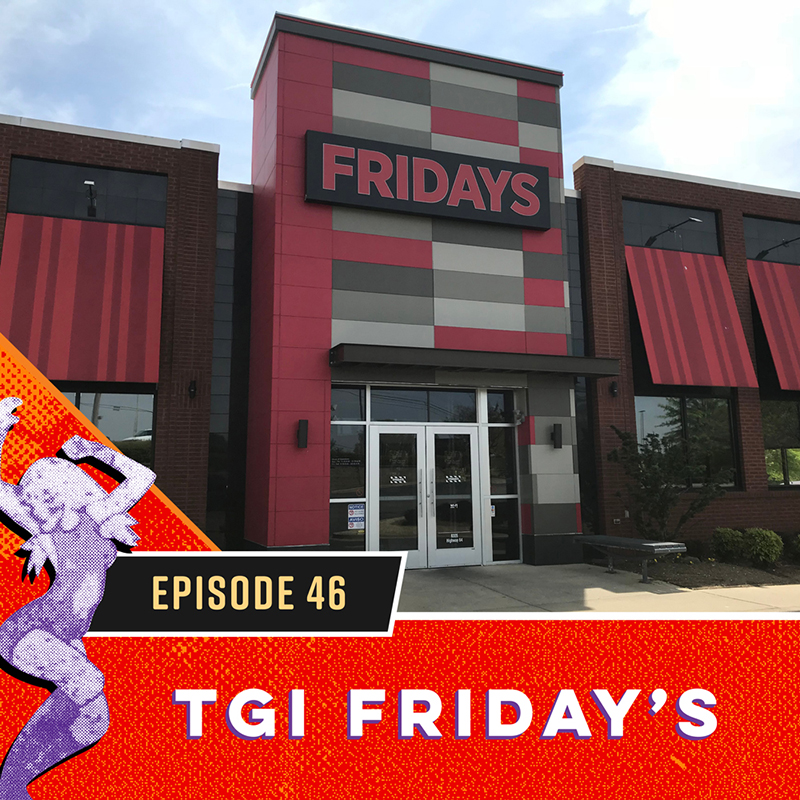
Monday May 14, 2018
TGI Fridays
Monday May 14, 2018
Monday May 14, 2018
In this episode of Memphis Type History: The Podcast, Rebecca tells Caitlin about how TGI Friday's is where people meeting at bars basically originated. You'll learn the story of how Memphis made it a franchise, and how without TGI Friday's, Caitlin may have never been born.
In 2016, TGI Fridays announced that they would be adopting a new, modernized aesthetic atmosphere. It seems to be in a trend, older chain restaurants are becoming more industrial and minimalistic in design to compete with the current competition such as Panera and Chipotle.
So all the restaurants that we grew up with like Chili's, Fuddruckers, and Joe's Crabshack may all start losing that hoarder style aesthetic if they haven't done so already. Oh by the way, that hoarder-style aesthetic happened because of TGIFridays. The initial concept was to make it feel like you were visiting someone's basement for a cocktail party.
How it all began...
Alan Stillman lived in an area of New York where there were a lot of airline stewardesses and models and basically a lot of single people. So he the best way to meet girls was to open a bar.
At the time, cocktail parties were the thing. People would bounce from one place to another and of course the parties would get wild. But Alan noticed there wasn’t really a public place for these 23-37 year olds to meet. The current bars around were more like places for guys to meet up and drink beer.
So he opened TGI Fridays in 1965 and just five years later, FDA approved the pill. The timing happened perfectly because the sexual revolution waves in and Alan essentially becomes the founder of the first single's bar.
Alan purchased a former corner bar near where he lived, had the building painted blue, hung up fake Tiffany lamps and dressed the waiters in red and white striped soccer shirts. He didn’t know anything about restaurant business, interior design, or architecture… he just knew how to create an experience.
TGI Fridays was one of the first to use promotions such as ladies’ night. And the goal of meeting women worked for him. In fact, he says Tom Cruise’s character in Cocktail was based after him.
Eventually, someone from Memphis Tennessee approached Alan and said they had an area with room for one of these and asked him if he would sell them a franchise. At the time, Alan didn’t know what a franchise meant. But he agreed to being a partner, show how to work it, and split it 50/50. A year and a half later, T.G.I. Friday’s in Memphis was open in Overton Square.
This was right after Overton Square Founders & Developers James D. Robinson, Jr. (23), Ben Woodson (25), Charles H. Hull, Jr. (24), and Frank Doggrell, III (25) led the efforts to pass a referendum to allow establishments to sell liquor by the drink. You couldn’t dine in a restaurant and have an alcoholic drink with your meal. You could apparently bring your own bottle of wine or liquor, which they called Brown-bagging, and places like Pete and Sam’s had lockers where you could keep your liquor, but you couldn’t buy a drink.
Then on November 25, 1969, the issue of “liquor by the drink” came to vote in a special referendum, and the measure passed. Friday’s opened on May 21, 1970 and it was a ridiculous success. One of the owners said if they could make $800 a day, they would break even. The first day, it brought $4,800 and it did the same every day until they expanded it, in which they went up to $7,000 a day. One of the waiters said it would be so crowded, they had to fight through customers. People would stand three and four deep at the bar, and he knows somebody had sex at the bar one night but nobody noticed because it was so crowded.
The waiters were all men because as mentioned before, the goal was to get women in the door, and most of the bartenders and waiters had nicknames such as Gringo, Harpo, The General, Shakey, Chick, Pace, and Rufus. Rebecca made sure to ask Caitlin's mom if she knew who any of these bartenders are. She didn't remember the names, but she does still own one of the original tablecloths. (not for purchase)
For full show notes visit memphistypehistory.com/fridays
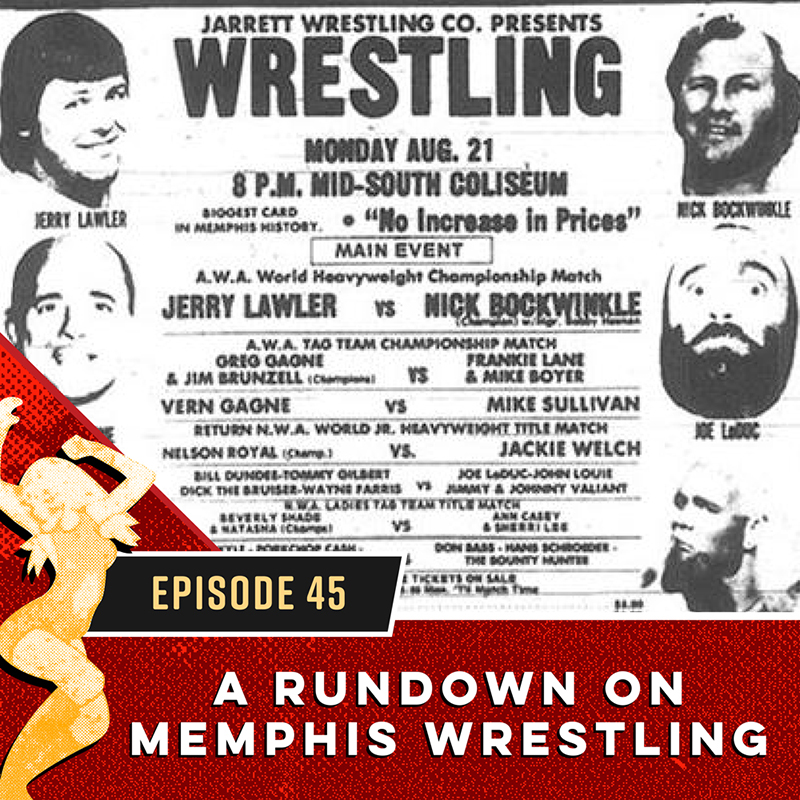
Monday May 07, 2018
A Rundown on Memphis Wrestling
Monday May 07, 2018
Monday May 07, 2018
In this episode of Memphis Type History: The Podcast, Rebecca gets educated on the art of wrestling and learns why Memphis is rich in this particular history. We hear from Adam Pritchard, a devoted wrestling fan who visits Memphis in hopes of encountering one of the many heroes he only ever experienced by watching tv from across the pond.
First, we asked what memories you had of Memphis wrestling and we shared a few of those stories to kick us off on what the highlights were. But what ended up happening was it gave Rebecca a lot of questions. What was with these wrestling names? Was "Handsome Jimmy Valiant" truly handsome? What was the Fargo strut?
Fortunately, her brother-in-law, Adam Pritchard, is very passionate about wrestling and was the one who informed her that Memphis was a big deal in this sport. When Adam came to visit Memphis, the highlight of his trip was touring the Channel 5 station because that's where DAVE BROWN was. Another visit highlight was King Jerry Lawler's Hall of Fame Bar & Grille.
And so it came to be that out of curiosity of this topic, Rebecca interviewed Adam to learn exactly why he loves wrestling so much and what role Memphis had in this entertainment that she was unaware of.
Adam starts by telling how he fell in love with wrestling and what he remembers most about what he first started watching. He says there is more to wrestling than what we may realize and you can tune in to the episode to hear what his current favorite type of wrestling is.
He also gives a 101 on wrestling. Was it always staged? Was there always a story? The answer is yes. It was a way to engage the audience to follow along with the wrestler and his character or story.
One character that many are familiar with is Hulk Hogan who was considered as one of the "good guys." However, Rebecca learns that one city's hero could enter another wrester's territory and become the bad guy for that city.
Jerry "The King" Lawler was an example of a wrestler who was seen as a good guy and hero in Memphis but seen as a bad guy in other territories that he crossed into, fighting the good guy wrestlers in those places. The best part was that him as a bad guy in, for example, Florida or Texas, wasn't televised in Memphis. So he remained as only a bad guy in the eyes of other territories because that's all they saw.
Today you don't really see that anymore because everything is pretty much national.
So how did Adam even knew about all of this at a time when it wasn't national and he watched wrestling in England?
He said the way fans connected and learned all the stories was through wrestling magazine and VHS tape trading.
Adam then talks about how the Mid-South Coliseum was where wrestling was at and even about a particular show that happened there between Terry Funk and Jerry Lawler when the arena was completely empty. You can imagine the tape trading was huge with that one because no one was there to see it.
While Memphis was known for not being the most well-paid territory for wrestlers, it was a territory that many wrestlers came through because it was well-respected and gave them great exposure and experience.
In addition to learning about the greatness of the Coliseum, I learn about the role of the announcers, other well-known Memphis wrestlers like Sputnik Monroe, and the famous beef between Andy Kaufman and Jerry Lawler, who I discovered has a dangerous signature move. Learning that it was all staged also made me realize wrestling can actually be quite convincing.
To sum it all up, if you're a true wrestling fan, you probably have a high respect for Memphis and it's a good territory to be in.
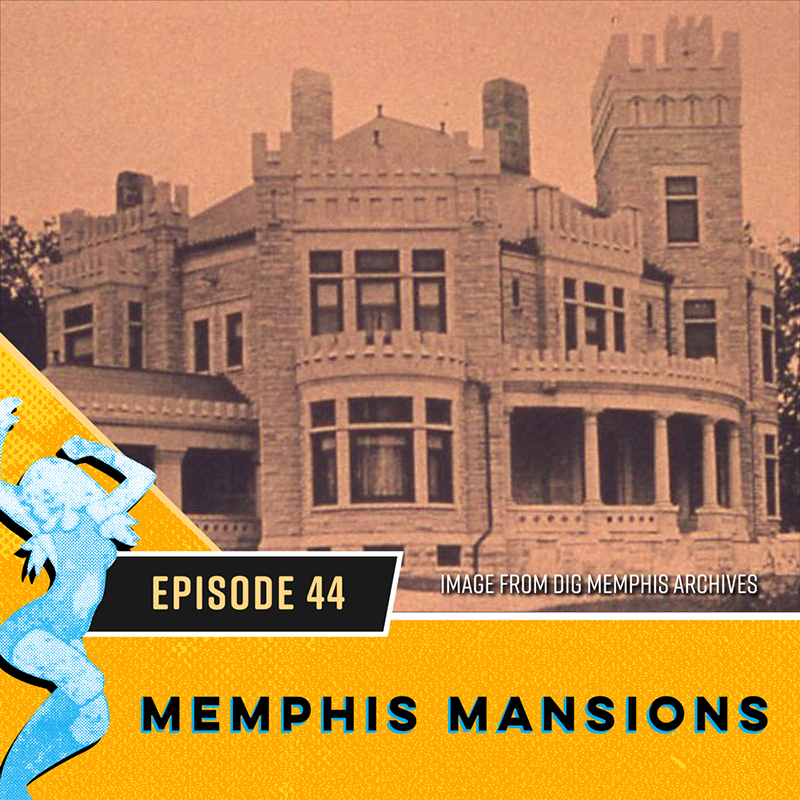
Monday Apr 30, 2018
Memphis Mansions
Monday Apr 30, 2018
Monday Apr 30, 2018
In this episode of Memphis Type History: The Podcast, we look at the history behind a few Memphis mansions. Hear from Caitlin about Ashlar Hall's many lives and the history behind the Woodruff Fontaine House. Then hear Rebecca tell a little history and description of the Annesdale mansion which could be your next wedding location.
Ashlar Hall
Robert Brinkley Snowden grew up in Annesdale with his parents, Robert Bogardus Snowden and Annie Overton Brinkley Snowden, who lived in the Annesdale mansion because Annie’s dad bought it for them (learn more about Annesdale from Rebecca later in the show!) He went to Princeton to study architecture and returned to Memphis in 1896 to build everyone’s favorite 11,000 square foot local castle at 1937 Central Avenue – Ashlar Hall!
This quote that Creme de Memph dug up from Memphis: An Architectural Guide about the Gothic Revival Mansion was simply delightful: "one wonders what books about medieval castles Snowden brought back with him from Princeton, or perhaps the whole may have been influenced by a too-early reading of Ivanhoe."
The three-story, 8-bedroom mansion only cost $24,900 to build, which is $683,767.48 in today’s money. Inside are six bars, five bathrooms, and a swimming pool. Rumor has it there are two secret passages under the mansion: One passing under Lamar to Snowden mansion in Annesdale and the other leading under Central to the University Club’s pool area.
Snowden would go on to take over the Peabody Hotel when it relocated in 1925, as the original one was started by his great-grandfather, Colonel Robert C. Brinkley, back in 1869.
After Robert died in 1942, the place went into disrepair and became a Grisanti’s restaurant called Conestoga Steak House at some point in the ‘60s. In 1970 it became Ashlar Hall Restaurant. In 1983 it was added to the National Register of Historic Places.
The mansion’s next life began in the ‘90s when Prince Mongo turned it into a nightclub called the Castle for a few years before abandoning it. Sometime around 2013, ownership started switching around for Ashlar Hall and the property fell further into disrepair. There are links below for the latest on its current life.
Woodruff-Fontaine House
This mansion of Memphis is located at 680 Adams in the heart of Victorian Village.
In 1845, Amos Woodruff and his brother arrived in Memphis from Rahway, New Jersey, with the intent of expanding their business of making carriages. Although his brother went back to New Jersey, Amos found great success with carriages in Memphis and his other ventures: the Overton Hotel, two banks, a cotton compress firm, a lumber company, running the Memphis & Ohio Railroad, and the Southern Life Insurance Company
In 1870, Woodruff spent $12,000 on land in “Millionaire’s Row,” in what was then the outskirts of Memphis. It's now known as Victorian Village, and it was here that he started building his five-story French Victorian mansion at a cost of $40,000. He also built a carriage house on the property alongside beautiful gardens and fountains. He lived in this 18-room mansion, with its three great halls and a three-story tower, with his wife, Phoebe, and their four children: Sallie, Mollie, Frank, and Cora.
Many believe that the Woodruff-Fontaine house is haunted by Mollie Woodruff’s ghost. Some haunted moments include staff seeing Mollie's form in smoke, seeing her sitting on the bed in her former childhood room, and her demonstrations of anger like slamming doors and breaking items when anything gets moved or redecorated. Supposedly, her bed is sometimes dented as if someone has been lying there.... even though it’s roped off from all visitors. One paranormal website said she once told museum docents how they should have the furniture arranged. So of course we have to tell you more about her in this episode!
In the 1960s, the mansion was in danger of demolition. So the Memphis chapter of the Association for the Preservation of Tennessee Antiquities started raising funds to renovate the property. They outfitted it for modern times, restored antique elements, and even found a fresco on one of the ballroom’s ceilings! It opened back up in 1964, although it wasn’t quite finished up at that point yet. Many people donated the furniture and stuff that’s inside, and how it’s a proper museum showing 1800s life in Memphis!
Annesdale Mansion
The Annesdale mansion was built in 1850 on Lamar Avenue which, at the time, was called Pigeon Roost Road. The home was originally built by Dr. Samuel Mansfield, a wholesale druggist from Maryland, on 200 acres on the outskirts of Memphis. Nineteen years later, Colonel Robert Brinkley, the guy who built the Peabody Hotel bought the estate as a wedding gift to his daughter Annie and it was named Annesdale, for Annie's Dale.
Since 1869, Annesdale has been home to the same family for at least 7 generations.
Annie married Col. Robert Bogardus Snowden. And for 160 years, members of the socially prominent Snowden family lived here. It is Italian Villa in style, built with bricks made on the site. It has a four-story tower which overlooks the current seven and a half acre park-like setting.
The Details
The Annesdale is an 1850 antebellum mansion nestled amongst seven and a half acres of elegant lawns and gardens. It holds a grand parlor, spiral staircase, and a marble entryway.
A great description can be found in a Memphis Magazine article which states,
We were told that the +17,000-square-foot home has 13 rooms, five bedrooms, and four and a half baths. The downstairs public spaces have 14-foot ceilings, and the period details include: 11 fireplaces, pocket doors, carved walnut paneling, intricate needlework panels over the windows, stained glass, painted ceilings with exquisite figural details, ornate plasterwork and lustrous oak floors. Ken Robison is the one who purchased the home and estate in 2010 and rennovated and reopened the mansion as an event space. He says the Snowdens have been extremely gracious in helping him buy back antique pieces from family members that were original to the home. He has found additional items that once belonged there through other sources. In particular, he is especially proud of the portrait of Annie Overton Brinkley which hangs in the music room. As history tells us, when Annie married Colonel Robert Bogardus Snowden, her father, Colonel Robert C. Brinkley, made Annesdale a wedding gift from her father. And as the new owner likes to say, 'Annie has come home at last.'
A later discovery...
In 2016 a bone fragment, possibly human, was found in the grate of a boarded-up fireplace inside the mansion when a photographer came across it during a photoshoot. It went under investigation but Rebecca couldn't find if a verdict was ever made aside from knowledge that it was very very old, likely from the Civil War era which would make sense since the mansion did serve as a hospital during that time. If anyone knows of any updates on the discovery, please tell!
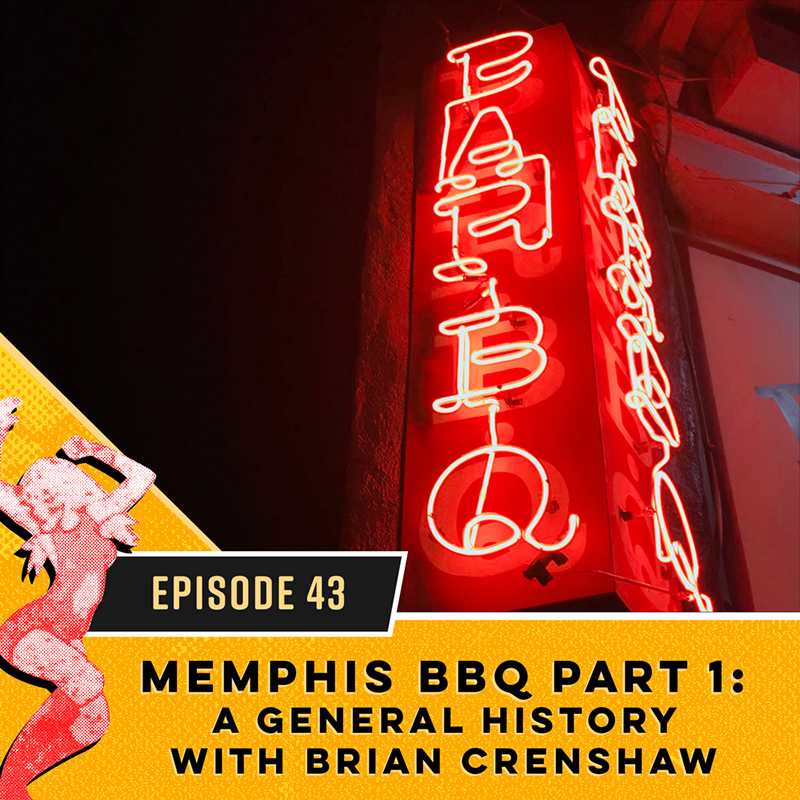
Sunday Apr 15, 2018
Memphis BBQ Part 1: A General History with Brian Crenshaw
Sunday Apr 15, 2018
Sunday Apr 15, 2018
In this episode of Memphis Type History: The Podcast, Rebecca seeks out the history of barbecue instead of just eating it. In this first part of what will become a series of Memphis BBQ stories, we hear from Brian Crenshaw, a gentleman who has spent a good time diving into the history of where it originated and how Memphis's culture really generated the satisfying flavors we thoroughly enjoy today.
Let's start with the first pigs that came to America. They were 13 black Iberian pigs and were brought to Tampa Bay, Florida in 1539 by Hernando de Soto. They joined the Spanish conquistadors during their journeys through the Southeast and were used to start pig farms for the new Spanish colony. As you can imagine, people loved the taste of them. It's even been reported that American Indians were so fond of the taste of pork that attacks to acquire it resulted in some of the worst assaults on the expedition.
Brian talks about where the word barbecue or barbeque originated from (barbacoa) and the simplicity of beginning as an actual pit people would walk up to. It would eventually evolve into a drive-in and then into a sit-down restaurant. A good example of a place that likely developed through this process is Corky's BBQ because of its apparent expansions.
A favorite of Brian's and another great example of this primitive style of barbecue resides in Brownsville, TN, called Helen's Bar BQ.
Wonder which barbecue restaurant in Memphis is the oldest?
Brian believes that would be Leonard's which has served original Memphis style pit barbecue since 1922. Leonard's Pit Barbecue is honestly the only place I've ever heard of that offers a barbecue buffet. Even more interesting, is when Brian tells us that Leonard's is where the custom of putting coleslaw on the sandwich may have started. It was a way to stretch their meat when times tough economically, however it turns out the mix of flavors is quite a marriage and thus coleslaw stands as a traditional topping.
Finally hear about how new bbq innovations started in Memphis, like barbecue nachos and pizza. Hear from Brian why Memphis barbecue is much more than just a good meal. It is so rich in Memphis history. There are so many different places to eat barbecue and each has their own rich history and relationships that make them unique from each other. It says something that this city can support so many of these local "mom and pop" shops. It's because they are true culinary artists.
For full show notes, visit memphistypehistory.com/barbeque
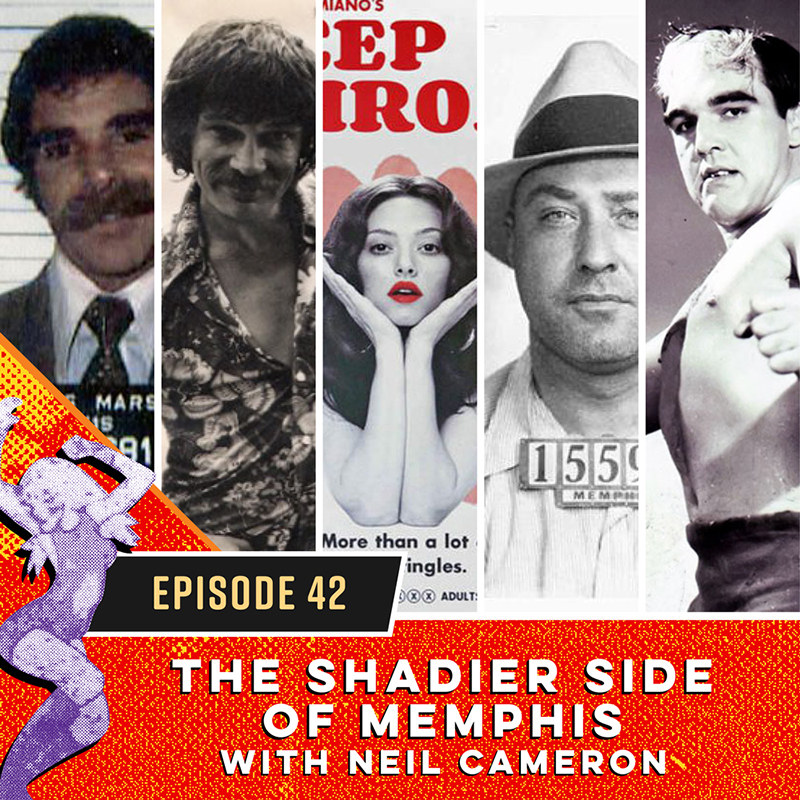
Monday Apr 09, 2018
The Shadier Side of Memphis with Neil Cameron
Monday Apr 09, 2018
Monday Apr 09, 2018
In this episode of Memphis Type History: The Podcast, Caitlin connects with Neil Cameron of Strickly Elvis UK to talk about Elvis... no not actually...instead more of the shadier side of Memphis that has nothing to do with Elvis. Hear Caitlin and Neil from distant lands talk about a few crime stories that you may or may not know about.
So how did Memphis Type History and Strickly Elvis UK collide? We try to remember ourselves. While it may have been Facebook that brought us together, it was Sun Studios that gave us a meeting place. And while it's good to catch up a little, we went straight to the gritty stories that Neil has learned over time of this city he loves and visits so much.
First up... Jerry Mcgill.
For full show notes, visit memphistypehistory.com/crime
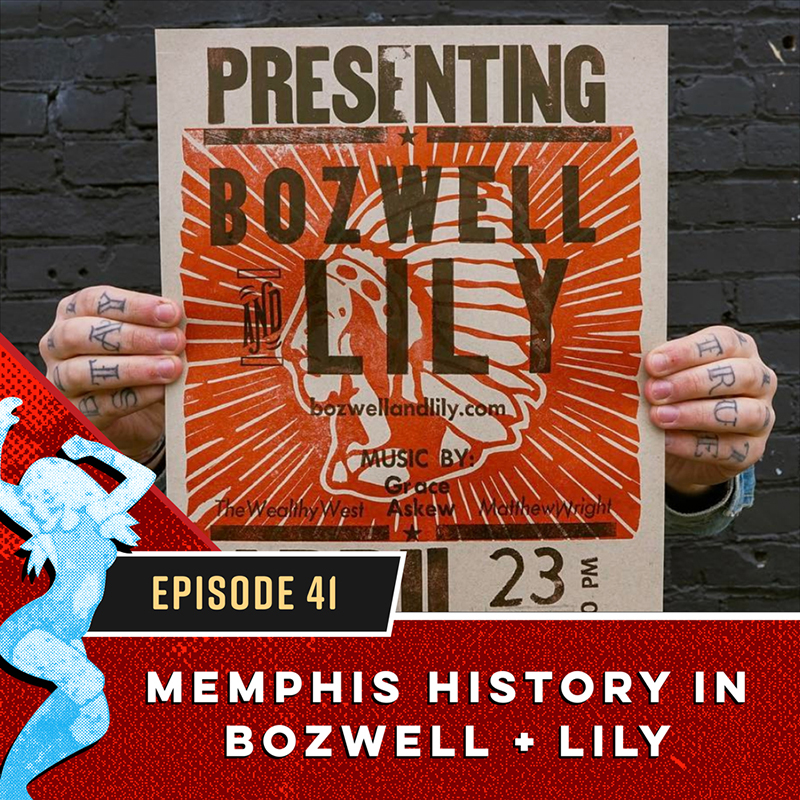
Sunday Apr 01, 2018
Memphis History in Bozwell + Lily
Sunday Apr 01, 2018
Sunday Apr 01, 2018
In this episode of Memphis Type History: The Podcast, Rebecca meets with Ben Fulfer, the man behind Bozwell + Lily, to talk about his journey and decision on starting this company. He tells us the thoughtful process behind what items he chooses to sell, who he works with, and the Memphis inspiration and history that some of his products tell.
First, did you know...?
We don’t mention this on the podcast, but did you know Ben was once a radio DJ? He also recently redesigned the setup at Ditty TV because he’s got the skills for design and aesthetics. Put these skill sets together + a traveling man with motivation and inspiration and you get Bozwell + Lily, a small shop with a lot of history and thoughtful design.
So who are Bozwell and Lily?
Well, they are Ben’s beloved dogs. And when you hear the personality each possess, you gather how it perfectly embodies the theme of the shop. When Ben tells the story of how the shop got started and its process of growth, he connects how the personalities of his pups each reflected that process.
What is the story behind the ’46 tee we most often see?
This is the tee with the Native American screen print shown above. Rebecca thought it was maybe a nod to a particular Memphis native American who perhaps made history by fighting a tribe of coyotes and saving a village. She was close… it is actually a nod to the Memphis baseball team called, “the chicks” preexisting the Red Birds we know and salute today. In particular, this imprint is something we would have seen on their jerseys in the year of ’46 which isn’t the most recognizable. If you Google Memphis Chick images, it will be a long time of scrolling before you come across this particular logo.
It then occurred to Rebecca that a good number of Bozwell + Lily products have this same vintage feel and inspiration. The type of fabric…the imagery…the banners…the hand-stitching…the screen printing…these are all details made to give each product its own type of thumbprint with a process that pays tribute to days of long ago.
Where did it start?
The first product of Bozwell + Lily was the B.B. King imprint tee. Ben tells us the story of creating that shirt, how much it cost, and how it gave him the courage to keep moving forward. Also, if you happen to own one of these shirts with the misspelled name “Boswell + Lily” on the tag, you know you have a Memphis original.
For full show notes, go to memphistypehistory.com/bozwell
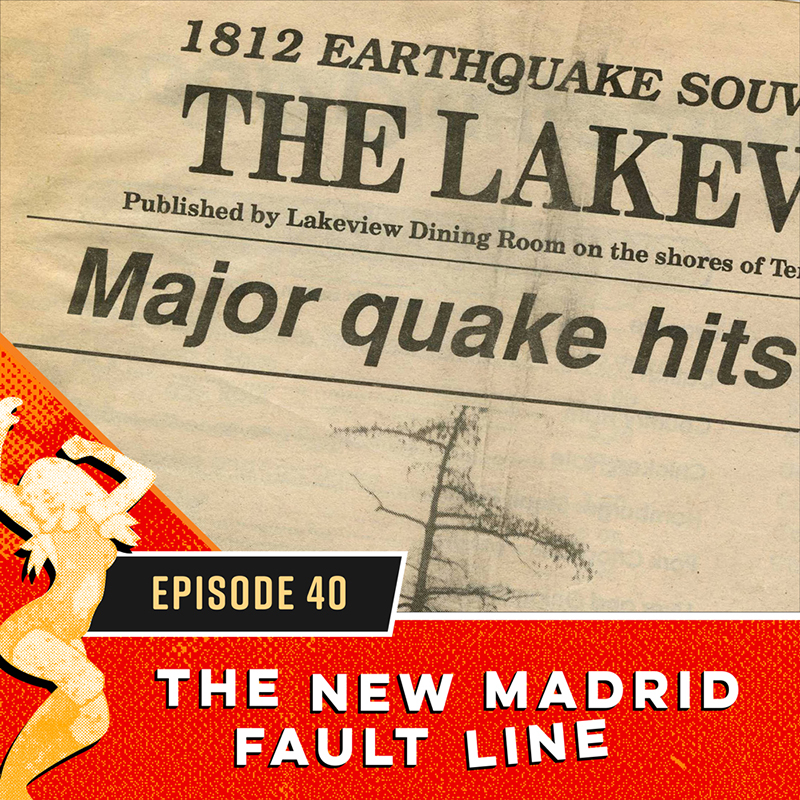
Monday Mar 26, 2018
The New Madrid Fault Line
Monday Mar 26, 2018
Monday Mar 26, 2018
In this episode of Memphis Type History: The Podcast, Rebecca reveals to Caitlin her recent paranoia of the New Madrid fault line and the seriousness of "the big one" for Memphis should it ever occur. But there's good new! Well... at least for those over 36 years old.
So what is the New Madrid Fault Line?
Wikipedia says it's the 150-mile (240 km) long seismic zone, which extends into five states. It stretches southward from Cairo, IL; through Hayti, Caruthersille and New Madrid, MO; through Blytheville into Marked Tree in AR. It also covers a part of West Tennesse, near Reelfoot Lake, extending southeast into Dyersburg.
That's a pretty big stretch of land.
The History of New Madrid Seismic Zone (NMSZ) Earthquakes
The first known written record of an earthquake felt in the NMSZ was from a French missionary traveling up the Mississippi with a party of explorers. It happened at 1 p.m. on Christmas Day in 1699 at a site near the present-day location of Memphis.
However, most famous was a series of 3 earthquakes between 1811-12.
The first earthquake was recorded at 2:15 am in Northeast Arkansas. It caused only slight damage to man-made structures, mostly because it wasn’t greatly populated. Memphis (before it was Memphis) was shaken at a Mercalli Intensity scale of level nine. Little Prairie, MO was destroyed by soil liquefaction, trees were knocked down and riverbanks collapsed. Uplifts of the ground on the riverbed and large waves made the Mississippi river look like it was flowing upstream. Sand bars and points of islands gave way. A steamboat crew that was anchored overnight along a Mississippi River island said they awoke to find the island had disappeared below the water. Landslides covered an area of 78,000 - 129,000 square kilometers, extending from Cairo, Illinois, to Memphis, Tennessee, and from Crowley's Ridge in northeastern Arkansas to Chickasaw Bluffs, Tennessee. This event shook windows and furniture in Washington, D.C., rang bells in Richmond, Virginia, shook houses in Charleston, South Carolina, and knocked plaster off of houses in Columbia, South Carolina. Observers in Herculaneum, Missouri said it had a duration of 10-12 minutes. After all this, only one life was lost in falling buildings.
The first and largest aftershock happened that same morning at around 7:15am. It came to be known as the “Dawn” Aftershock.
The second earthquake, on January 23, is believed to be the smallest of the three main shocks and also believed by some that the epicenter was in southern Illinois. That raises concern because if that is true, then that would mean and extended section of the fault exists.
The third earthquake, on February 7, happened in Missouri and it was the largest of the series. It destroyed the town of New Madrid, it damaged many houses in St. Louis. It caused general ground warping, ejections, fissuring, severe landslides, and caving of stream banks. Uplift along the fault created temporary waterfalls on the Mississippi River and caused the formation of Reelfoot Lake.
NMSZ Fun Facts: (because we try to make light of dark topics)
• There’s a New Madrid Historical Museum in the Missouri boot heel. There you can watch a VHS tape they play on loop, called “The Night the Earth went Crazy.”
• In 1990, there was an earthquake hype. A prophecy had just been made by a self-proclaimed climatologist named Iben Browning, who falsely claimed to have predicted the 1989 Loma Prieta earthquake in California the year before. He predicted that a magnitude 7 earthquake would strike New Madrid on December 3, 1990. The prediction had no scientific legitimacy but it was widely reported in the national media, which promoted fear, anxiety, and hysteria among residents of the Mississippi Valley.
• In Memphis, the city recently spent $25 million to prevent the pyramid from being swallowed.
• AutoZone’s corporate headquarters also stands ready for some massive shakes. It’s propped up on top of giant shock absorbers.
• The nearby Memphis VA is another safe spot. The city spent $64 million dollars removing nine floors of the hospital to reduce the risk of collapse in a catastrophic earthquake.
And if you would like more hope, we talk about Seth Stein, a seismologist and professor at Northwestern who doesn’t think we should be worried about the New Madrid. Rebecca talks about his theory on the episode which sounds pretty solid.
But for all you Eeyores and Debbie Downers, Rebecca also talks about how scientist say Seth's scenario is a low probability scenario and that the NMSZ is still hazardous. They estimate that over the next 50 years, the probability of a magnitude 6 or larger quake is between 25 to 40 percent.
In short, if you are 36 years old or younger, there is a good chance you will experience an earthquake in the Mid-South that measures higher than a 6.
